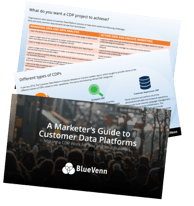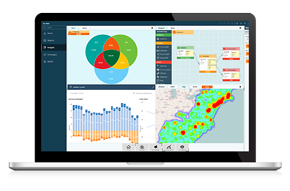 The explosion in do-it-yourself online bookings and the trend for bundled holiday products over the last decade has made knowing and defining the target market more important than ever within the travel & leisure industry. It used to be enough to segment customers by core demographics – their age, residential location and life stage, for example – but reaching the right customer with the right message in a competitive digital arena has become much trickier.
The explosion in do-it-yourself online bookings and the trend for bundled holiday products over the last decade has made knowing and defining the target market more important than ever within the travel & leisure industry. It used to be enough to segment customers by core demographics – their age, residential location and life stage, for example – but reaching the right customer with the right message in a competitive digital arena has become much trickier.
Not only must the travel marketer think about reaching the customer on the right platform, they must also consider what experience that customer is looking for and take care to deliver it. If they don’t, somebody else will. In order to give the customer want they want, first they must get to know them.
What is segmentation?
Segmentation involves drilling down into the market of potential customers to create precise audiences based on demographics, lifestyle, attitude, value and more.

In other words, rather than trying to please everyone, carving out and targeting a specific group, made up of people who all want the same thing from your brand.
This makes perfect sense when you think about just how large and varied the travel and leisure market is today. Influencers have inspired people to covet experiences they never imagined could be within their reach; cheap flights have made such trips a viable option and bundling sites like Expedia and Kayak have ensured that even timid, inexperienced travelers can put together a bespoke travel experience, including end-to-end transport, hotel bookings, hire car and selected activities, using their own computer or mobile. Now anyone can be a world traveler, so brands must target people who want what they can offer.
How can travel & leisure companies perfect their targeting?
Targeting the modern traveler isn’t as easy as sticking them into a block segment, such as those traveling for business, pleasure or adventure. As this TravelDailyNews International article points out, even an apparently clear-cut segment like ‘luxury travel’ can be broken down into customers looking for uber-luxury, vanity-driven luxury and ethical luxury, with each band looking for very different experiences.
For example, the uber-luxury seekers will be looking for a degree of exclusivity and will be put off by social media advertising, while the vanity-driven traveler will be focused on visuals and the possibility of sharing with friends (with 72% thinking it’s important that their holiday looks good on social media). Meanwhile, the ethical traveler will be drawn to campaigns suggesting they might be the first member of their peer group to go on a trip or communications outlining the ethical credentials of an experience or hotel.
In fact, there’s a whole raft of potential segments that people could fit into, each with different service requirements, expectations and communication preferences. Dawning Digital breaks them down into the broad categories of geographics, including country, language and climate, demographics, including age, education and income, psychographics, including values, lifestyle and interests, and behavioural, including intent, occasion and life cycle. If you are able to define a specific segment based on subject characteristics, rather than relying on broad assumptions, you can target that band far more effectively.
A Marketer’s Guide to Customer Data Platforms eBook

For example, if you group together every male, living in London, aged in their 30s and looking for adventure, you might end up sending them all English language communications about extreme activity hosteling holidays in Australia, with white water rafting, scuba diving and bungee jumping.
However, drill a little deeper into the customers’ booking motivations and you might find a sub-sector of French speaking fathers of young families with a specific interest in ethical travel (in common with 88% of Millennials, according to eight&four’s Generation Travel 2019 survey). For these people, dangerous pursuits would be out, as would long flights and non-family-friendly hotels. Instead, French language communications about family activity holidays in Spain with horses, bike riding and hikes or UK eco-lodges near nature reserves, outdoor play centers or farms might be more appropriate.
But how can you get to know your customers in this sort of detail and get a better idea of the best way to market your services to a particular segment (assuming they are in fact the right group to approach with what you have to offer)? Will they respond best to email communications, letters or phone calls, social media ads or videos and images? What message will speed them towards a purchase? What USP will instantly arouse their interest?
How to pick out your perfect segment(s)
There’s a lot to think about when identifying and targeting the perfect group of customers to match your brand, especially motivation, message and channel.
![]() Motivation: what is important to your customer? According to Medium, 90% of travelers expect a personalized experience. Meanwhile, Tnooz found that 95% read reviews before they travel. Understanding what your customers want will help turn them into fans and spokespeople, who will promote the virtues of your service not only to friends and family, but online. If you can follow search histories or, in the case of known customers, see which previous topics have prompted a response (such as a specific country, price range or search term), this will reveal their preferences. It will also help you to group them with like-minded customers.
Motivation: what is important to your customer? According to Medium, 90% of travelers expect a personalized experience. Meanwhile, Tnooz found that 95% read reviews before they travel. Understanding what your customers want will help turn them into fans and spokespeople, who will promote the virtues of your service not only to friends and family, but online. If you can follow search histories or, in the case of known customers, see which previous topics have prompted a response (such as a specific country, price range or search term), this will reveal their preferences. It will also help you to group them with like-minded customers.
![]() Message: knowing potential customers’ demographics, online habits and response histories will help you to reach similar groups with the right tone, offer and topic. If you have a segment of Generation Z people who love adventure sports, why not target them with a video explaining that they can win an Alpine trekking holiday for 2 by sharing the film with 5 friends on Facebook? When addressing customers who are into ethical travel, talk about charity projects your company supports or the offsetting measures you’ve taken, to get them excited about your brand values. Draw in parents of small children using a newsletter interview with one of your company’s ‘Little Monsters’ club leads.
Message: knowing potential customers’ demographics, online habits and response histories will help you to reach similar groups with the right tone, offer and topic. If you have a segment of Generation Z people who love adventure sports, why not target them with a video explaining that they can win an Alpine trekking holiday for 2 by sharing the film with 5 friends on Facebook? When addressing customers who are into ethical travel, talk about charity projects your company supports or the offsetting measures you’ve taken, to get them excited about your brand values. Draw in parents of small children using a newsletter interview with one of your company’s ‘Little Monsters’ club leads.
![]() Channel: where is your customer traditionally found? If a segment is known to open emails but skirt past social media ads, email is the way to go. If they like to book through a travel agent, post them details of your partnership with Thomas Cook where they can use your code to get a discount. If they’re students who spends hours on Facebook, why not target them through a Facebook competition the way Contiki did in the UK?
Channel: where is your customer traditionally found? If a segment is known to open emails but skirt past social media ads, email is the way to go. If they like to book through a travel agent, post them details of your partnership with Thomas Cook where they can use your code to get a discount. If they’re students who spends hours on Facebook, why not target them through a Facebook competition the way Contiki did in the UK?
Right on target
In today’s fast moving travel and leisure market, customers expect to be targeted with personalized messages. Sorting your customer data into clear segments is the first step towards making sure you target the right customers, at the right time, in the right way to drive sales. A Customer Data Platform will help you to create the Single Customer View you need to ensure every customer is placed in the right segment to ensure targeted communications hit home.
Find out more about BlueVenn's Customer Data Platform. Register to see a live demonstration now.
Register for the next presentation to learn how to:
- Use predictive analytics to make real-time decisions that positively affect the customer journey
- Improve targeting of campaigns using customer segmentation and RFV analysis
- Use real-time personalization to better engage customers
- Integrate online and offline channels into the BlueVenn Customer Data Platform to create a true Single Customer View











